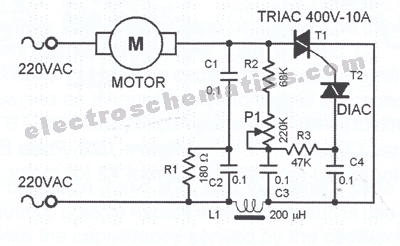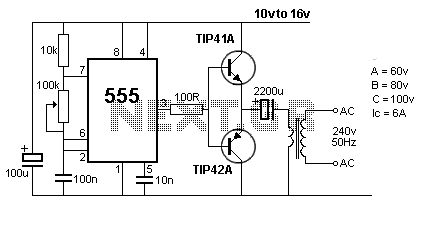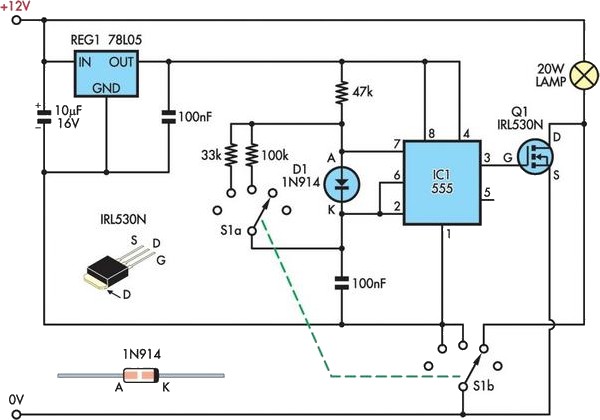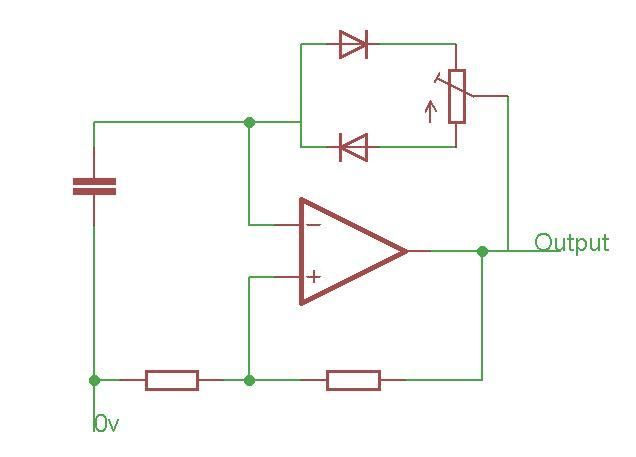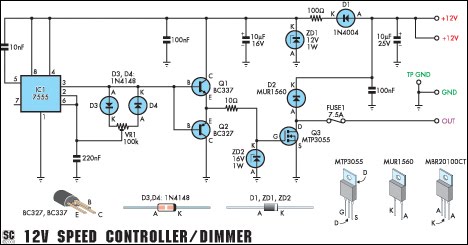
12V Speed Controller/Dimmer
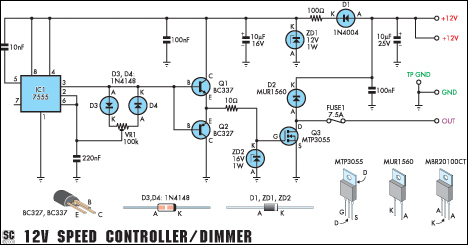
This circuit functions as a speed controller for a 12V motor with a continuous rating of up to 5A or as a dimmer for a 12V halogen or incandescent lamp rated up to 50W. It adjusts the power to the load (motor or lamp) using pulse width modulation (PWM) at a frequency of approximately 220Hz. SILICON CHIP has developed various DC speed controllers over the years, including a high-power 24V 40A design featured in the March & April 2008 issues and a popular 12V/24V 20A design from June 1997, along with several reversible 12V designs. However, many of these designs may be excessive for simpler applications, which is why this basic circuit is introduced. It utilizes a 7555 timer IC, a MOSFET, and minimal additional components. The design lacks features such as motor back-EMF monitoring for enhanced speed regulation and sophisticated overload protection, relying instead on a fuse. Despite its simplicity, the circuit is efficient and cost-effective. It can be employed in various applications involving 12V motors, fans, or lamps, suitable for use in cars, boats, recreational vehicles, model boats, and model railways. The circuit can effectively control a 12V fan in a car, caravan, or computer. It employs a 7555 timer (IC1) to generate variable-width pulses at approximately 210Hz, which drives MOSFET Q3 (via transistors Q1 and Q2) to manage the speed of a motor or dim an incandescent lamp. While the circuit can dim 12V halogen lamps, it is noted that this method is inefficient. For applications requiring dimmable 12V lamps, it is advisable to use 12V LED lamps, which are now widely available in various bases, including standard bayonet, miniature Edison screw (MES), and MR16 halogen. These LED lamps are more efficient, generate less heat, and have a significantly longer lifespan compared to halogen lamps.
The circuit design begins with the 7555 timer IC, which is configured in astable mode to produce a PWM signal. The output frequency is set to approximately 210Hz, which is suitable for controlling the speed of DC motors or adjusting the brightness of incandescent lamps. The duty cycle of the PWM signal can be varied by adjusting the resistance and capacitance values connected to the timer, allowing for fine-tuning of the motor speed or lamp brightness.
The PWM output from the timer drives a pair of transistors (Q1 and Q2) configured as a push-pull driver. This configuration ensures that the MOSFET (Q3) receives sufficient gate drive voltage to switch on and off effectively, allowing for efficient power control to the load. The MOSFET is selected based on its current and voltage ratings, ensuring it can handle the maximum load of 5A for motors or 50W for lamps.
For protection, a fuse is included in the circuit to prevent damage from overcurrent conditions. However, it is important to note that this simple design does not include features such as thermal shutdown or back-EMF protection, which could enhance the reliability of the circuit in more demanding applications.
Overall, this circuit is a practical solution for applications requiring basic speed control or dimming of 12V loads, offering a straightforward and cost-effective approach for hobbyists and engineers alike.This handy circuit can be used as a speed controller for a 12V motor rated up to 5A (continuous) or as a dimmer for a 12V halogen or standard incandescent lamp rated up to 50W. It varies the power to the load (motor or lamp) using pulse width modulation (PWM) at a pulse frequency of around 220Hz.
SILICON CHIP has produced a number of DC speed cont rollers over the years, the most recent being our high-power 24V 40A design featured in the March & April 2008 issues. Another very popular design is our 12V/24V 20A design featured in the June 1997 issue and we have also featured a number of reversible 12V designs.
For many applications though, most of these designs are over-kill and a much simpler circuit will suffice. Which is why we are presenting this basic design which uses a 7555 timer IC, a Mosfet and not much else.
Being a simple design, it does not monitor motor back-EMF to provide improved speed regulation and nor does it have any fancy overload protection apart from a fuse. However, it is a very efficient circuit and the kit cost is quite low. There are many applications for this circuit which will all be based on 12V motors, fans or lamps. You can use it in cars, boats, and recreational vehicles, in model boats and model railways and so on.
Want to control a 12V fan in a car, caravan or computer This circuit will do it for you. The circuit uses a 7555 timer (IC1) to generate variable width pulses at about 210Hz. This drives Mosfet Q3 (via transistors Q1 & Q2) to control the speed of a motor or to dim an incandescent lamp. While the circuit can dim 12V halogen lamps, we should point out that dimming halogen lamps is very wasteful.
In situations where you need dimmable 12V lamps, you will be much better off substituting 12V LED lamps which are now readily available in standard bayonet, miniature Edison screw (MES) and MR16 halogen bases. Not only are these LED replacement lamps much more efficient than halogen lamps, they do not get anywhere near as hot and will also last a great deal longer.
🔗 External reference
The circuit design begins with the 7555 timer IC, which is configured in astable mode to produce a PWM signal. The output frequency is set to approximately 210Hz, which is suitable for controlling the speed of DC motors or adjusting the brightness of incandescent lamps. The duty cycle of the PWM signal can be varied by adjusting the resistance and capacitance values connected to the timer, allowing for fine-tuning of the motor speed or lamp brightness.
The PWM output from the timer drives a pair of transistors (Q1 and Q2) configured as a push-pull driver. This configuration ensures that the MOSFET (Q3) receives sufficient gate drive voltage to switch on and off effectively, allowing for efficient power control to the load. The MOSFET is selected based on its current and voltage ratings, ensuring it can handle the maximum load of 5A for motors or 50W for lamps.
For protection, a fuse is included in the circuit to prevent damage from overcurrent conditions. However, it is important to note that this simple design does not include features such as thermal shutdown or back-EMF protection, which could enhance the reliability of the circuit in more demanding applications.
Overall, this circuit is a practical solution for applications requiring basic speed control or dimming of 12V loads, offering a straightforward and cost-effective approach for hobbyists and engineers alike.This handy circuit can be used as a speed controller for a 12V motor rated up to 5A (continuous) or as a dimmer for a 12V halogen or standard incandescent lamp rated up to 50W. It varies the power to the load (motor or lamp) using pulse width modulation (PWM) at a pulse frequency of around 220Hz.
SILICON CHIP has produced a number of DC speed cont rollers over the years, the most recent being our high-power 24V 40A design featured in the March & April 2008 issues. Another very popular design is our 12V/24V 20A design featured in the June 1997 issue and we have also featured a number of reversible 12V designs.
For many applications though, most of these designs are over-kill and a much simpler circuit will suffice. Which is why we are presenting this basic design which uses a 7555 timer IC, a Mosfet and not much else.
Being a simple design, it does not monitor motor back-EMF to provide improved speed regulation and nor does it have any fancy overload protection apart from a fuse. However, it is a very efficient circuit and the kit cost is quite low. There are many applications for this circuit which will all be based on 12V motors, fans or lamps. You can use it in cars, boats, and recreational vehicles, in model boats and model railways and so on.
Want to control a 12V fan in a car, caravan or computer This circuit will do it for you. The circuit uses a 7555 timer (IC1) to generate variable width pulses at about 210Hz. This drives Mosfet Q3 (via transistors Q1 & Q2) to control the speed of a motor or to dim an incandescent lamp. While the circuit can dim 12V halogen lamps, we should point out that dimming halogen lamps is very wasteful.
In situations where you need dimmable 12V lamps, you will be much better off substituting 12V LED lamps which are now readily available in standard bayonet, miniature Edison screw (MES) and MR16 halogen bases. Not only are these LED replacement lamps much more efficient than halogen lamps, they do not get anywhere near as hot and will also last a great deal longer.
🔗 External reference
Warning: include(partials/cookie-banner.php): Failed to open stream: Permission denied in /var/www/html/nextgr/view-circuit.php on line 713
Warning: include(): Failed opening 'partials/cookie-banner.php' for inclusion (include_path='.:/usr/share/php') in /var/www/html/nextgr/view-circuit.php on line 713
